
In Christian architecture the baptistery or baptistry is the separate centrally planned structure surrounding the baptismal font. The baptistery may be incorporated within the body of a church or cathedral, and provided with an altar as a chapel. In the early Church, the catechumens were instructed and the sacrament of baptism was administered in the baptistery.

The Collegiate Church of St. Bartholomew is an historical building in Liège, Belgium. Founded outside the city walls, it was built in coal sandstone, starting in the late 11th century and lasting until the late 12th century. It underwent, like most ancient religious buildings, modifications through the centuries. Nevertheless, the Meuse Romanesque—Ottonian architecture character of its architecture remained deeply rooted. The 18th century saw the addition of two more aisles, the opening of a neoclassical portal in the walls of the westwork, and the French Baroque redecoration of the interior. The interior of the western section has recently been restored back to the original style.

The Palace of Venaria is a former royal residence and gardens located in Venaria Reale, near Turin in the Piedmont region in northern Italy. It is one of the Residences of the Royal House of Savoy, included in the UNESCO Heritage List in 1997.
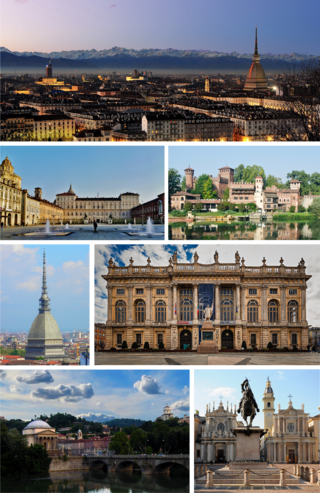
Turin is a city and an important business and cultural centre in Northern Italy. It is the capital city of Piedmont and of the Metropolitan City of Turin, and was the first Italian capital from 1861 to 1865. The city is mainly on the western bank of the Po River, below its Susa Valley, and is surrounded by the western Alpine arch and Superga hill. The population of the city proper is 847,287, while the population of the urban area is estimated by Eurostat to be 1.7 million inhabitants. The Turin metropolitan area is estimated by the OECD to have a population of 2.2 million.
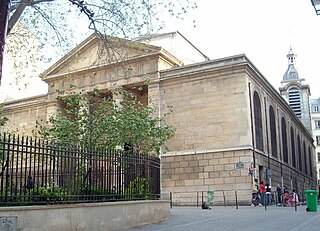
Notre-Dame-de-Bonne-Nouvelle, located at 25 Rue de la Lune, in the 2nd arrondissement of Paris and is a Catholic parish church built between 1823 and 1830. It is built in the Neoclassical style, and is dedicated to Notre-Dame de Bonne-Nouvelle, referring to the Annunciation. The neighbourhood of Bonne-Nouvelle, the Boulevard de Bonne-Nouvelle and the Bonne Nouvelle metro station are named after it. The church was registered as a national historical monument in 1983.

Batignano is a small town in southern Tuscany, a frazione of the comune of Grosseto, positioned at about 10 km north-east of the capital on one of the last foot-hills of the valley of Ombrone which dominated the ancient city of Roselle.

Maribo Cathedral is a Gothic cathedral church in Maribo on the island of Lolland in the southeast of Denmark. It was originally part of Maribo Abbey which was founded in the early 15th century. The chancel, the oldest section of the cathedral, probably dates from 1416. The plan of the church is unusual in that the chancel is at the west end of the building rather than the east as a result of the design instructions left by Saint Bridget.
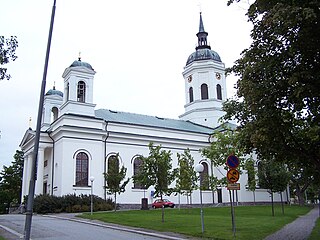
Härnösand Cathedral serves the Diocese of Härnösand of the Church of Sweden. It is located in Härnösand in Västernorrland County, Sweden. From atop the 46 metres tall tower, the entire town of Härnösand can be viewed.
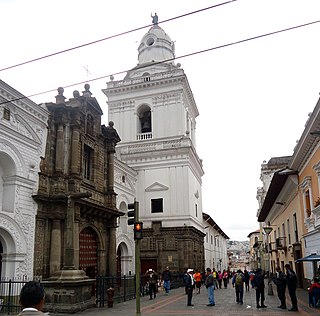
The Church and convent of San Agustín is a Catholic temple located in the Historic Center of the city of Quito, run by the Augustinian Order. The complex of the temple and convent is located on calle Chile, between Guayaquil and Flores.

The Church of Santa Maria al Monte dei Cappuccini is a late-Renaissance-style church on a hill overlooking the River Po just south of the bridge of Piazza Vittorio Veneto in Turin, Italy. It was built for the Capuchin Order; construction began in 1583, and was completed in 1656. The original design was by Ascanio Vitozzi, but was completed by Giacomo Soldati.

Santa Cristina is a Baroque style, Roman Catholic church located in Turin, region of Piedmont, Italy. It mirrors the adjacent church of San Carlo and faces the Piazza San Carlo. The arrangement recalls the twin churches of Santa Maria dei Miracoli (1681) and Santa Maria in Montesanto (1679) facing the Piazza del Popolo in Rome.

San Francesco da Paola is a Baroque style, Roman Catholic church located on Via di Po in Turin, region of Piedmont, Italy.

The Ascoli Piceno Baptistery, also known as the baptistery of Saint John, is a religious building found on the eastern end of the piazza Arringo at the center of Ascoli Piceno and sitting next to and just north of the cathedral dedicated to St. Emygdius, the city's patron saint.

The Church and Convent of Saint Dominic is a Roman Catholic church located in the city of Turin, Italy. Throughout its history it has served as a church, as inquisition tribunal, and as a masonic lodge.

Bjäresjö Church is a medieval church in Bjäresjö, in the province of Skåne, Sweden. The church contains several medieval mural paintings as well as a richly decorated Romanesque baptismal font.

The Church and Convent of Our Lady of Mount Carmel is a 17th-century Roman Catholic church and former convent in Salvador, Bahia, Brazil. The church is dedicated to Our Lady of Mount Carmel. The complex is adjacent to the Church of the Third Order of Mount Carmel. The Church and Convent of Our Lady of Mount Carmel was listed as a historic structure by National Institute of Historic and Artistic Heritage (IPHAN) in 1938 and is part of the Historic Center of Salvador UNESCO World Heritage Site.
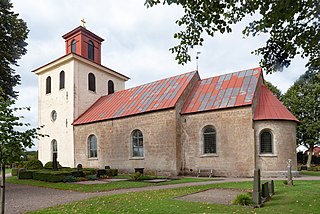
Norra Strö Church is a church in Norra Strö, a village in Kristianstad Municipality, Scania, Sweden. Built during the Middle Ages, it still contains medieval murals as well as a number of historical furnishings. The church was partially rebuilt during the 19th century and renovated in the 1940s. It belongs to the Church of Sweden.

The Convent of St. Clare is a former cloistered convent of the Order of Poor Clares, located in the city centre of Pontevedra, Spain, precisely in Santa Clara Street, near the disappeared St. Clare Gate of the medieval city walls. Founded in 1271, the convent closed in 2017. In 2021 the City Council bought the building from the Order, and in 2023 it transferred it to the Provincial Deputation to become part of the Pontevedra Museum.
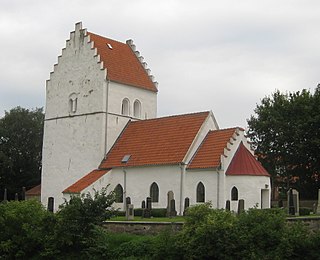
Ramsåsa Church is a medieval church in Ramsåsa, Scania, Sweden. It belongs to the Church of Sweden. It was built around 1200, and the tower added in the 15th century. The church contains medieval murals from three different periods, a late Romanesque rood cross and a medieval baptismal font.

Löderup Church is a medieval church in Löderup, Ystad Municipality, in the province of Skåne, Sweden. Dating from the 12th century, it has subsequently been expanded and rebuilt, not least under the guidance of architect Carl Georg Brunius in the 1860s. The church contains several old furnishings, including an unusual 12th-century baptismal font.
























